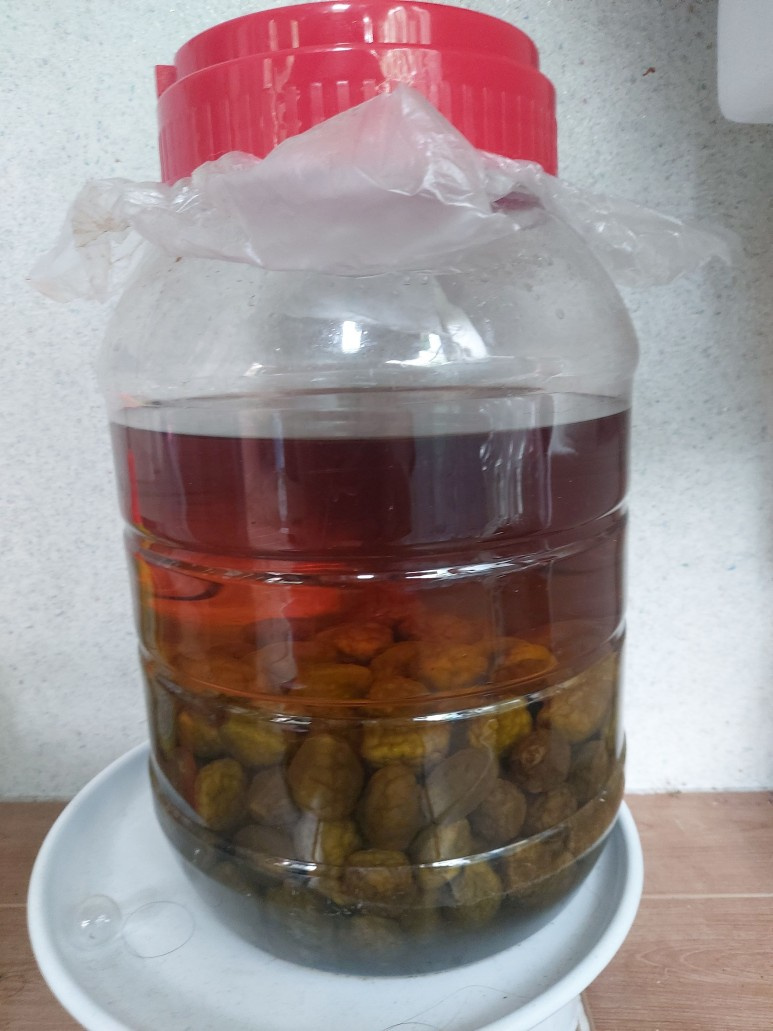1-Year Aged Plum Extract: A Deeply Flavored Sweetener
Opening Day: Unveiling the Richness of 1-Year Aged Plum Extract

Typically, plum extract is opened after 3 months. However, the toxic substance amygdalin in plums gradually decreases during the aging process and is completely broken down after one year. During this decomposition, the toxic gas hydrogen cyanide also volatilizes, making it safe to consume. Therefore, aging plum extract for about a year is highly recommended for optimal flavor and safety. For detailed research results on the benefits and how to make plum extract, please refer to my previous post. ★Learn About the Benefits and How to Make Plum Extract @7003394
Ingredients- Ripe Plums
- White Sugar (equal weight to plums)
Cooking Instructions
Step 1
The stems of the plums can cause a bitter taste. Use a toothpick to meticulously remove the stem from each plum. This step is crucial for achieving a clean and pleasant flavor in your plum extract.

Step 2
Wash the plums thoroughly under running water. Then, soak them in a solution of water with 1-2 tablespoons of vinegar for about 30 minutes for sterilization. Rinse them again with clean water. It’s vital to drain them completely on a colander until no moisture remains, as residual water can lead to mold growth. Once dried, lightly spray the plums with a mist of cooking sake or soju. This helps to preserve the plums.

Step 3
Now, it’s time to prepare the plum extract. Use a clean glass jar or ceramic pot. Lightly spray the inside with cooking sake for sterilization. Begin by layering a thin layer of sugar at the bottom of the container. Then, add a layer of the prepared plums. Alternate layers of plums and sugar, maintaining a 1:1 ratio by weight. Layering them this way helps the sugar dissolve evenly.

Step 4
Store the container in a cool, well-ventilated place away from direct sunlight. I placed mine in a shaded spot on my veranda. Proper ventilation helps prevent the growth of unwanted bacteria and promotes healthy fermentation.

Step 5
After 2-3 days, the sugar will start to dissolve. Gently stir the mixture with a spoon or by shaking the container to ensure the sugar doesn’t clump. Repeat this stirring process every day or two until the sugar is completely dissolved. This helps the plum juices and sugar to meld together harmoniously.

Step 6
Approximately two weeks later, most of the sugar will be dissolved, and the plum extract will begin to form. At this stage, use a lid or a clean, heavy object (like a food-grade stone) to press the plums down, ensuring they remain submerged and don’t float to the surface. Then, securely seal the opening of the container. I used a plant saucer to weigh down the plums and then covered the lid. This minimizes contact with air, preventing oxidation and further promoting aging.

Step 7
Skipping ahead, here’s what the plum extract looks like after one year of aging. Although I used white sugar, the color is incredibly deep and rich, resembling extract made with brown sugar. To be precise, it has been aged for 17 months. As the weather cooled down, I decided to strain it to prepare for the kimchi-making season.

Step 8
Place a fine-mesh sieve over a large bowl. Pour the aged plums and their liquid into the sieve, straining out the plum solids and collecting the clear plum extract. The color is wonderfully deep and inviting, much like extract made with brown sugar. I highly recommend aging your plum extract for a full year, just like this. This ensures that any toxic substances like amygdalin are completely broken down, resulting in a clear, intensely flavored extract with no sediment.




